Cloud Computing Research Paper: Virtualization, Security, and Benefits
VerifiedAdded on 2022/08/25
|21
|5525
|22
Report
AI Summary
This research paper delves into the multifaceted realm of cloud computing, exploring its historical evolution, core functionalities, and transformative impact on modern businesses. It meticulously examines the concept of cloud computing, defining it as a dynamic model that provides on-demand access to a shared pool of configurable computing resources. The paper outlines the advantages of cloud computing, such as cost efficiency, scalability, and improved manageability, while also acknowledging its drawbacks. A significant portion of the research is dedicated to understanding how cloud computing leverages virtualization, a critical element that enables efficient resource allocation and system management. Furthermore, the paper investigates the various security measures and regulatory compliance aspects essential for protecting data within cloud environments. The study also touches upon the different types of cloud computing, including SaaS, IaaS, and PaaS, highlighting their respective roles. Overall, the research underscores the growing importance of cloud computing in the IT landscape, emphasizing its potential to drive innovation and enhance operational efficiency across diverse industries.
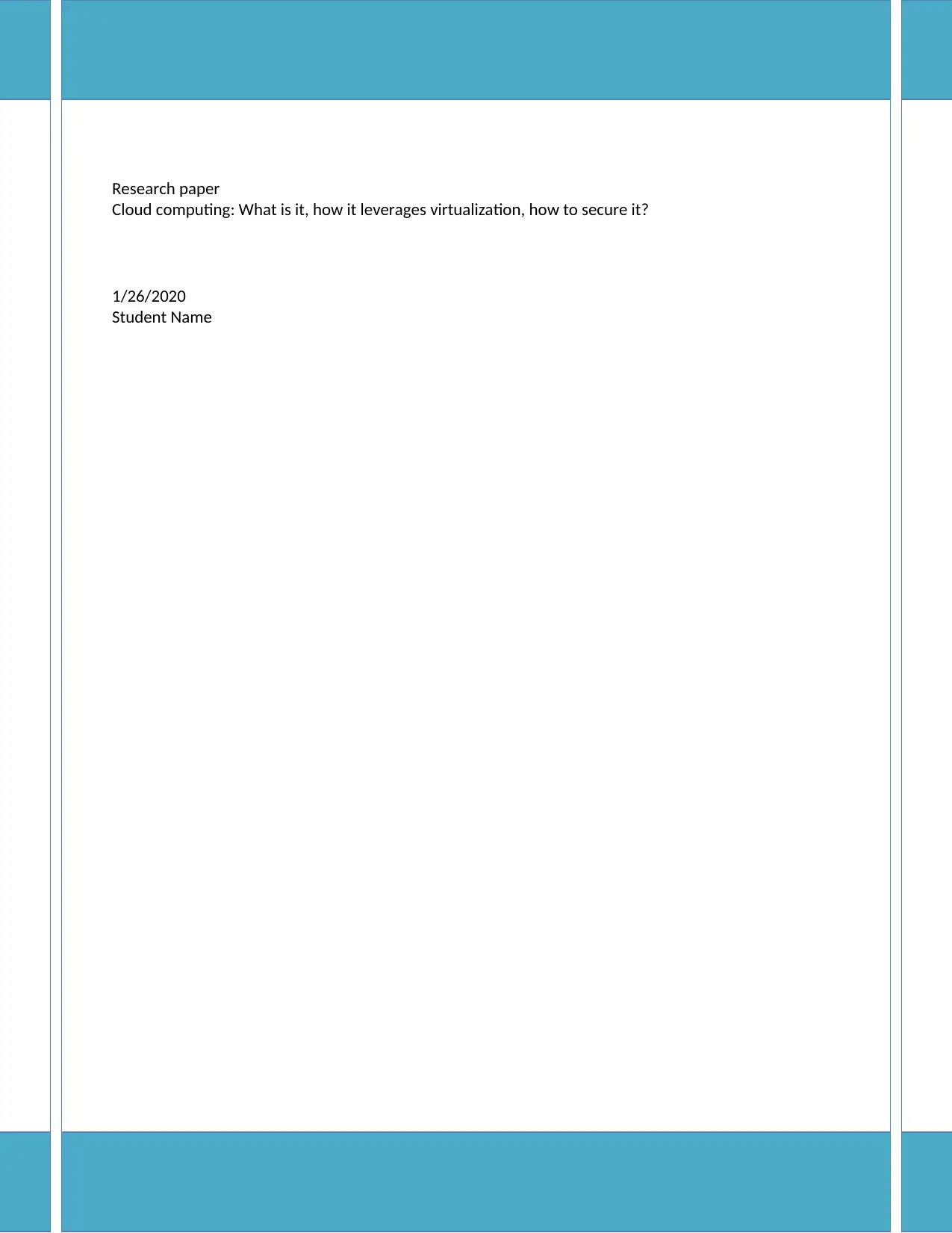
Research paper
Cloud computing: What is it, how it leverages virtualization, how to secure it?
1/26/2020
Student Name
Cloud computing: What is it, how it leverages virtualization, how to secure it?
1/26/2020
Student Name
Paraphrase This Document
Need a fresh take? Get an instant paraphrase of this document with our AI Paraphraser
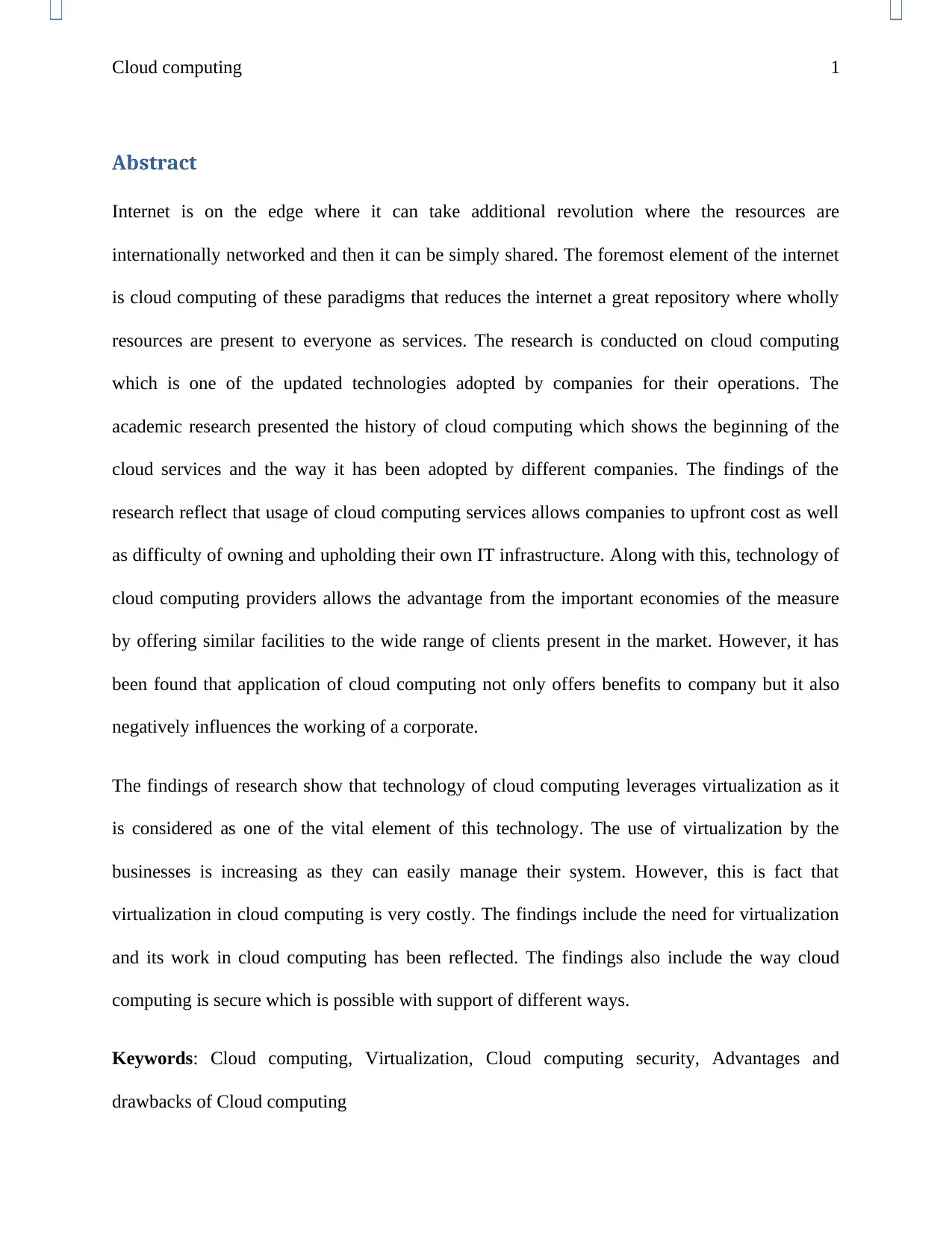
Cloud computing 1
Abstract
Internet is on the edge where it can take additional revolution where the resources are
internationally networked and then it can be simply shared. The foremost element of the internet
is cloud computing of these paradigms that reduces the internet a great repository where wholly
resources are present to everyone as services. The research is conducted on cloud computing
which is one of the updated technologies adopted by companies for their operations. The
academic research presented the history of cloud computing which shows the beginning of the
cloud services and the way it has been adopted by different companies. The findings of the
research reflect that usage of cloud computing services allows companies to upfront cost as well
as difficulty of owning and upholding their own IT infrastructure. Along with this, technology of
cloud computing providers allows the advantage from the important economies of the measure
by offering similar facilities to the wide range of clients present in the market. However, it has
been found that application of cloud computing not only offers benefits to company but it also
negatively influences the working of a corporate.
The findings of research show that technology of cloud computing leverages virtualization as it
is considered as one of the vital element of this technology. The use of virtualization by the
businesses is increasing as they can easily manage their system. However, this is fact that
virtualization in cloud computing is very costly. The findings include the need for virtualization
and its work in cloud computing has been reflected. The findings also include the way cloud
computing is secure which is possible with support of different ways.
Keywords: Cloud computing, Virtualization, Cloud computing security, Advantages and
drawbacks of Cloud computing
Abstract
Internet is on the edge where it can take additional revolution where the resources are
internationally networked and then it can be simply shared. The foremost element of the internet
is cloud computing of these paradigms that reduces the internet a great repository where wholly
resources are present to everyone as services. The research is conducted on cloud computing
which is one of the updated technologies adopted by companies for their operations. The
academic research presented the history of cloud computing which shows the beginning of the
cloud services and the way it has been adopted by different companies. The findings of the
research reflect that usage of cloud computing services allows companies to upfront cost as well
as difficulty of owning and upholding their own IT infrastructure. Along with this, technology of
cloud computing providers allows the advantage from the important economies of the measure
by offering similar facilities to the wide range of clients present in the market. However, it has
been found that application of cloud computing not only offers benefits to company but it also
negatively influences the working of a corporate.
The findings of research show that technology of cloud computing leverages virtualization as it
is considered as one of the vital element of this technology. The use of virtualization by the
businesses is increasing as they can easily manage their system. However, this is fact that
virtualization in cloud computing is very costly. The findings include the need for virtualization
and its work in cloud computing has been reflected. The findings also include the way cloud
computing is secure which is possible with support of different ways.
Keywords: Cloud computing, Virtualization, Cloud computing security, Advantages and
drawbacks of Cloud computing
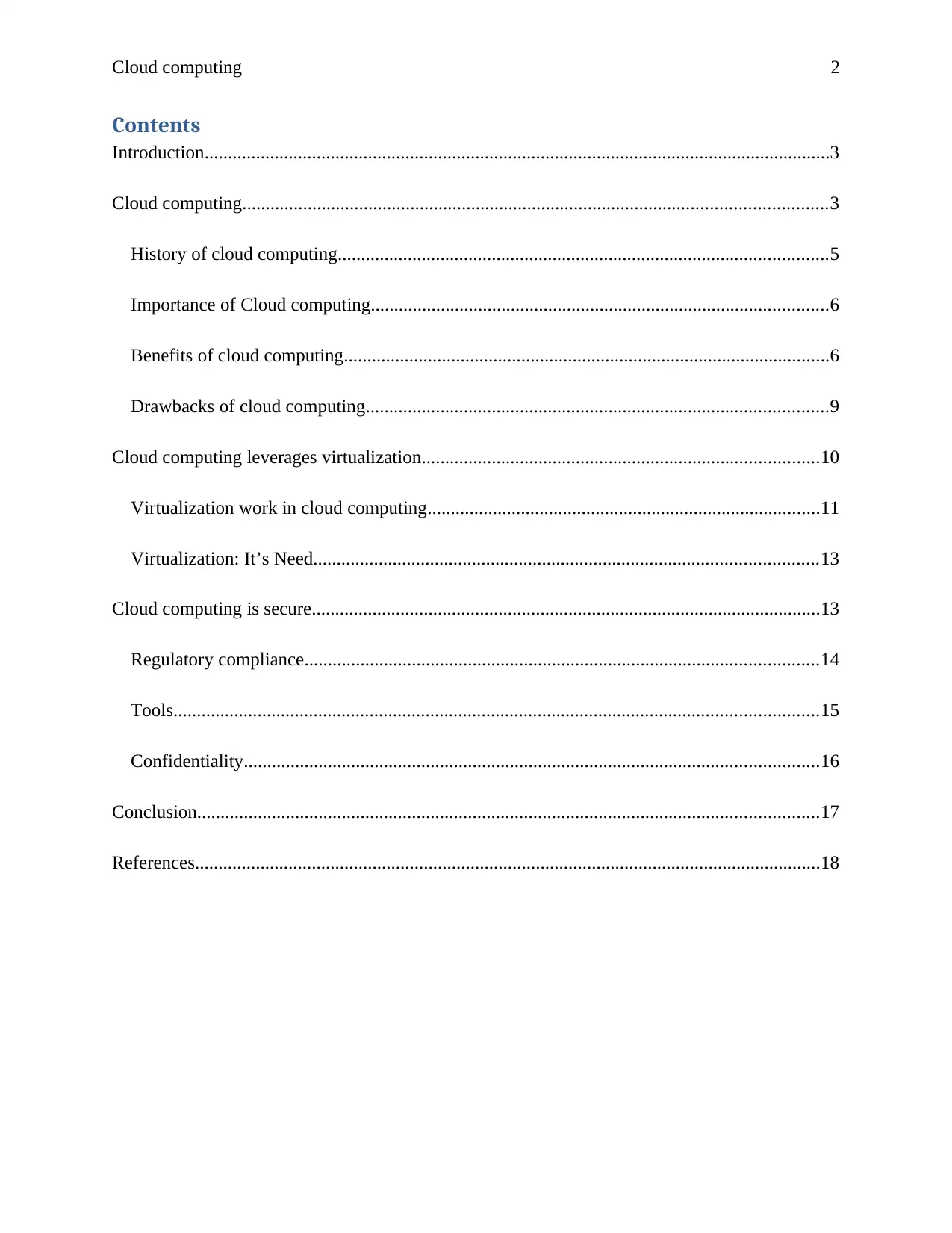
Cloud computing 2
Contents
Introduction......................................................................................................................................3
Cloud computing.............................................................................................................................3
History of cloud computing.........................................................................................................5
Importance of Cloud computing..................................................................................................6
Benefits of cloud computing........................................................................................................6
Drawbacks of cloud computing...................................................................................................9
Cloud computing leverages virtualization.....................................................................................10
Virtualization work in cloud computing....................................................................................11
Virtualization: It’s Need............................................................................................................13
Cloud computing is secure.............................................................................................................13
Regulatory compliance..............................................................................................................14
Tools..........................................................................................................................................15
Confidentiality...........................................................................................................................16
Conclusion.....................................................................................................................................17
References......................................................................................................................................18
Contents
Introduction......................................................................................................................................3
Cloud computing.............................................................................................................................3
History of cloud computing.........................................................................................................5
Importance of Cloud computing..................................................................................................6
Benefits of cloud computing........................................................................................................6
Drawbacks of cloud computing...................................................................................................9
Cloud computing leverages virtualization.....................................................................................10
Virtualization work in cloud computing....................................................................................11
Virtualization: It’s Need............................................................................................................13
Cloud computing is secure.............................................................................................................13
Regulatory compliance..............................................................................................................14
Tools..........................................................................................................................................15
Confidentiality...........................................................................................................................16
Conclusion.....................................................................................................................................17
References......................................................................................................................................18
⊘ This is a preview!⊘
Do you want full access?
Subscribe today to unlock all pages.

Trusted by 1+ million students worldwide
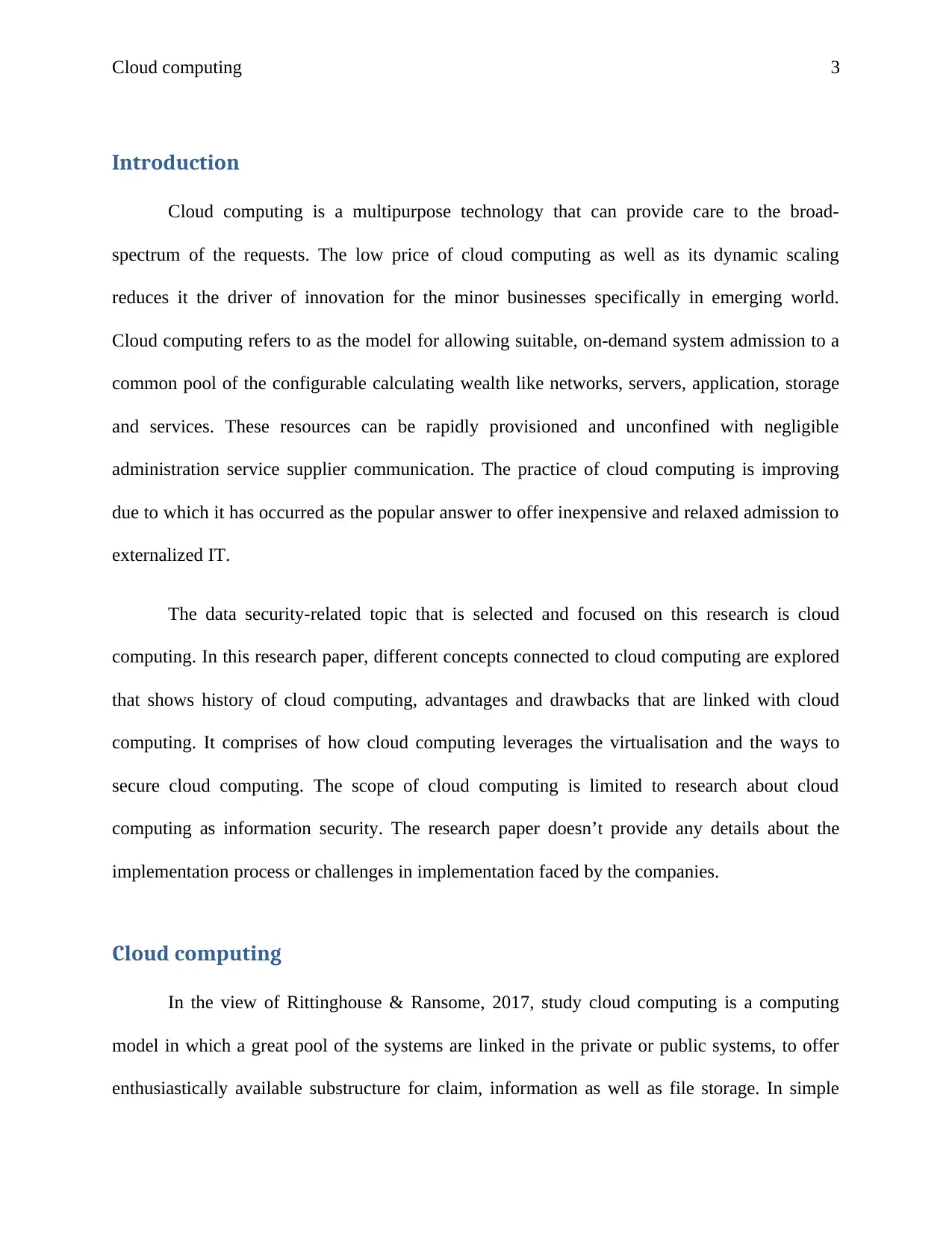
Cloud computing 3
Introduction
Cloud computing is a multipurpose technology that can provide care to the broad-
spectrum of the requests. The low price of cloud computing as well as its dynamic scaling
reduces it the driver of innovation for the minor businesses specifically in emerging world.
Cloud computing refers to as the model for allowing suitable, on-demand system admission to a
common pool of the configurable calculating wealth like networks, servers, application, storage
and services. These resources can be rapidly provisioned and unconfined with negligible
administration service supplier communication. The practice of cloud computing is improving
due to which it has occurred as the popular answer to offer inexpensive and relaxed admission to
externalized IT.
The data security-related topic that is selected and focused on this research is cloud
computing. In this research paper, different concepts connected to cloud computing are explored
that shows history of cloud computing, advantages and drawbacks that are linked with cloud
computing. It comprises of how cloud computing leverages the virtualisation and the ways to
secure cloud computing. The scope of cloud computing is limited to research about cloud
computing as information security. The research paper doesn’t provide any details about the
implementation process or challenges in implementation faced by the companies.
Cloud computing
In the view of Rittinghouse & Ransome, 2017, study cloud computing is a computing
model in which a great pool of the systems are linked in the private or public systems, to offer
enthusiastically available substructure for claim, information as well as file storage. In simple
Introduction
Cloud computing is a multipurpose technology that can provide care to the broad-
spectrum of the requests. The low price of cloud computing as well as its dynamic scaling
reduces it the driver of innovation for the minor businesses specifically in emerging world.
Cloud computing refers to as the model for allowing suitable, on-demand system admission to a
common pool of the configurable calculating wealth like networks, servers, application, storage
and services. These resources can be rapidly provisioned and unconfined with negligible
administration service supplier communication. The practice of cloud computing is improving
due to which it has occurred as the popular answer to offer inexpensive and relaxed admission to
externalized IT.
The data security-related topic that is selected and focused on this research is cloud
computing. In this research paper, different concepts connected to cloud computing are explored
that shows history of cloud computing, advantages and drawbacks that are linked with cloud
computing. It comprises of how cloud computing leverages the virtualisation and the ways to
secure cloud computing. The scope of cloud computing is limited to research about cloud
computing as information security. The research paper doesn’t provide any details about the
implementation process or challenges in implementation faced by the companies.
Cloud computing
In the view of Rittinghouse & Ransome, 2017, study cloud computing is a computing
model in which a great pool of the systems are linked in the private or public systems, to offer
enthusiastically available substructure for claim, information as well as file storage. In simple
Paraphrase This Document
Need a fresh take? Get an instant paraphrase of this document with our AI Paraphraser
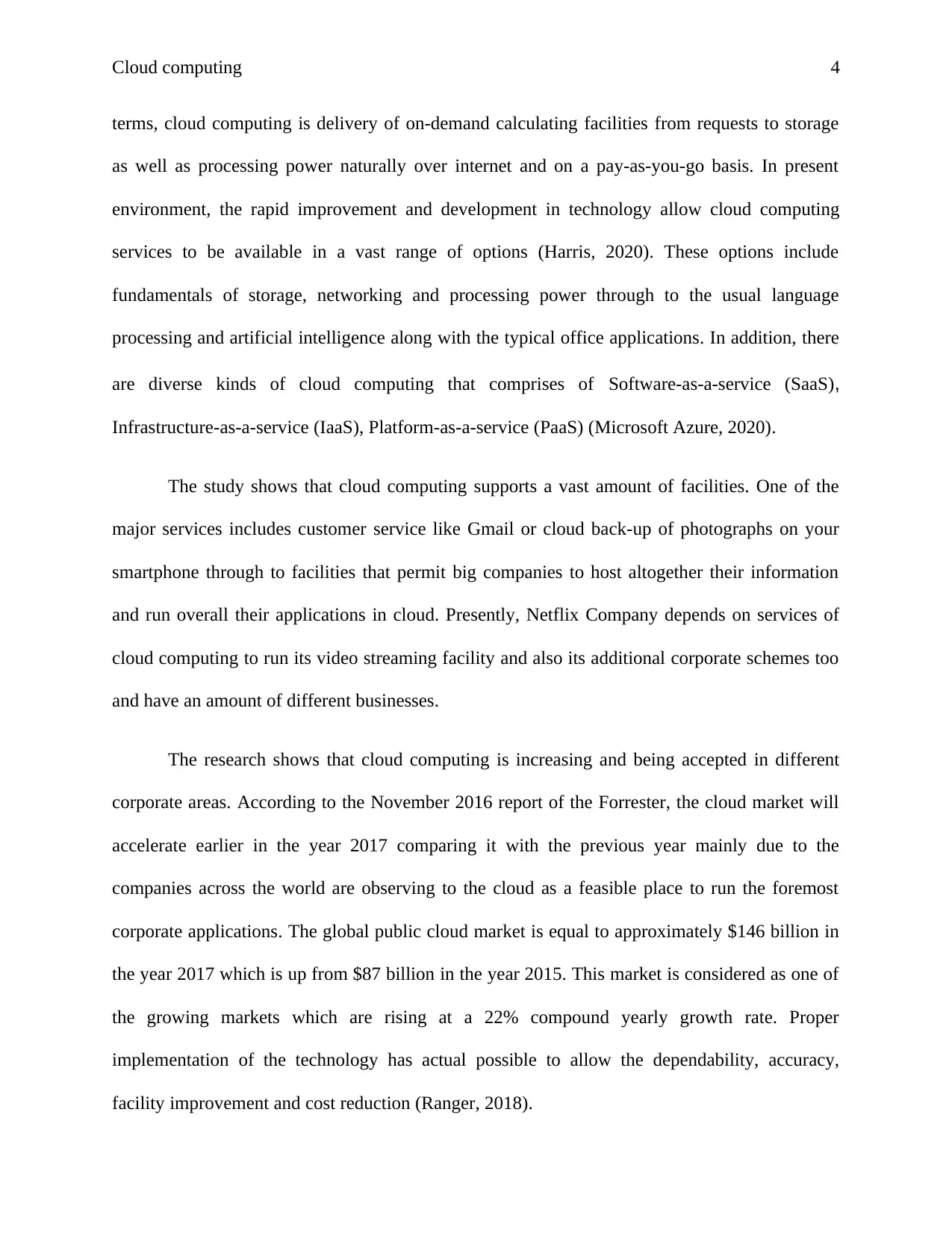
Cloud computing 4
terms, cloud computing is delivery of on-demand calculating facilities from requests to storage
as well as processing power naturally over internet and on a pay-as-you-go basis. In present
environment, the rapid improvement and development in technology allow cloud computing
services to be available in a vast range of options (Harris, 2020). These options include
fundamentals of storage, networking and processing power through to the usual language
processing and artificial intelligence along with the typical office applications. In addition, there
are diverse kinds of cloud computing that comprises of Software-as-a-service (SaaS),
Infrastructure-as-a-service (IaaS), Platform-as-a-service (PaaS) (Microsoft Azure, 2020).
The study shows that cloud computing supports a vast amount of facilities. One of the
major services includes customer service like Gmail or cloud back-up of photographs on your
smartphone through to facilities that permit big companies to host altogether their information
and run overall their applications in cloud. Presently, Netflix Company depends on services of
cloud computing to run its video streaming facility and also its additional corporate schemes too
and have an amount of different businesses.
The research shows that cloud computing is increasing and being accepted in different
corporate areas. According to the November 2016 report of the Forrester, the cloud market will
accelerate earlier in the year 2017 comparing it with the previous year mainly due to the
companies across the world are observing to the cloud as a feasible place to run the foremost
corporate applications. The global public cloud market is equal to approximately $146 billion in
the year 2017 which is up from $87 billion in the year 2015. This market is considered as one of
the growing markets which are rising at a 22% compound yearly growth rate. Proper
implementation of the technology has actual possible to allow the dependability, accuracy,
facility improvement and cost reduction (Ranger, 2018).
terms, cloud computing is delivery of on-demand calculating facilities from requests to storage
as well as processing power naturally over internet and on a pay-as-you-go basis. In present
environment, the rapid improvement and development in technology allow cloud computing
services to be available in a vast range of options (Harris, 2020). These options include
fundamentals of storage, networking and processing power through to the usual language
processing and artificial intelligence along with the typical office applications. In addition, there
are diverse kinds of cloud computing that comprises of Software-as-a-service (SaaS),
Infrastructure-as-a-service (IaaS), Platform-as-a-service (PaaS) (Microsoft Azure, 2020).
The study shows that cloud computing supports a vast amount of facilities. One of the
major services includes customer service like Gmail or cloud back-up of photographs on your
smartphone through to facilities that permit big companies to host altogether their information
and run overall their applications in cloud. Presently, Netflix Company depends on services of
cloud computing to run its video streaming facility and also its additional corporate schemes too
and have an amount of different businesses.
The research shows that cloud computing is increasing and being accepted in different
corporate areas. According to the November 2016 report of the Forrester, the cloud market will
accelerate earlier in the year 2017 comparing it with the previous year mainly due to the
companies across the world are observing to the cloud as a feasible place to run the foremost
corporate applications. The global public cloud market is equal to approximately $146 billion in
the year 2017 which is up from $87 billion in the year 2015. This market is considered as one of
the growing markets which are rising at a 22% compound yearly growth rate. Proper
implementation of the technology has actual possible to allow the dependability, accuracy,
facility improvement and cost reduction (Ranger, 2018).
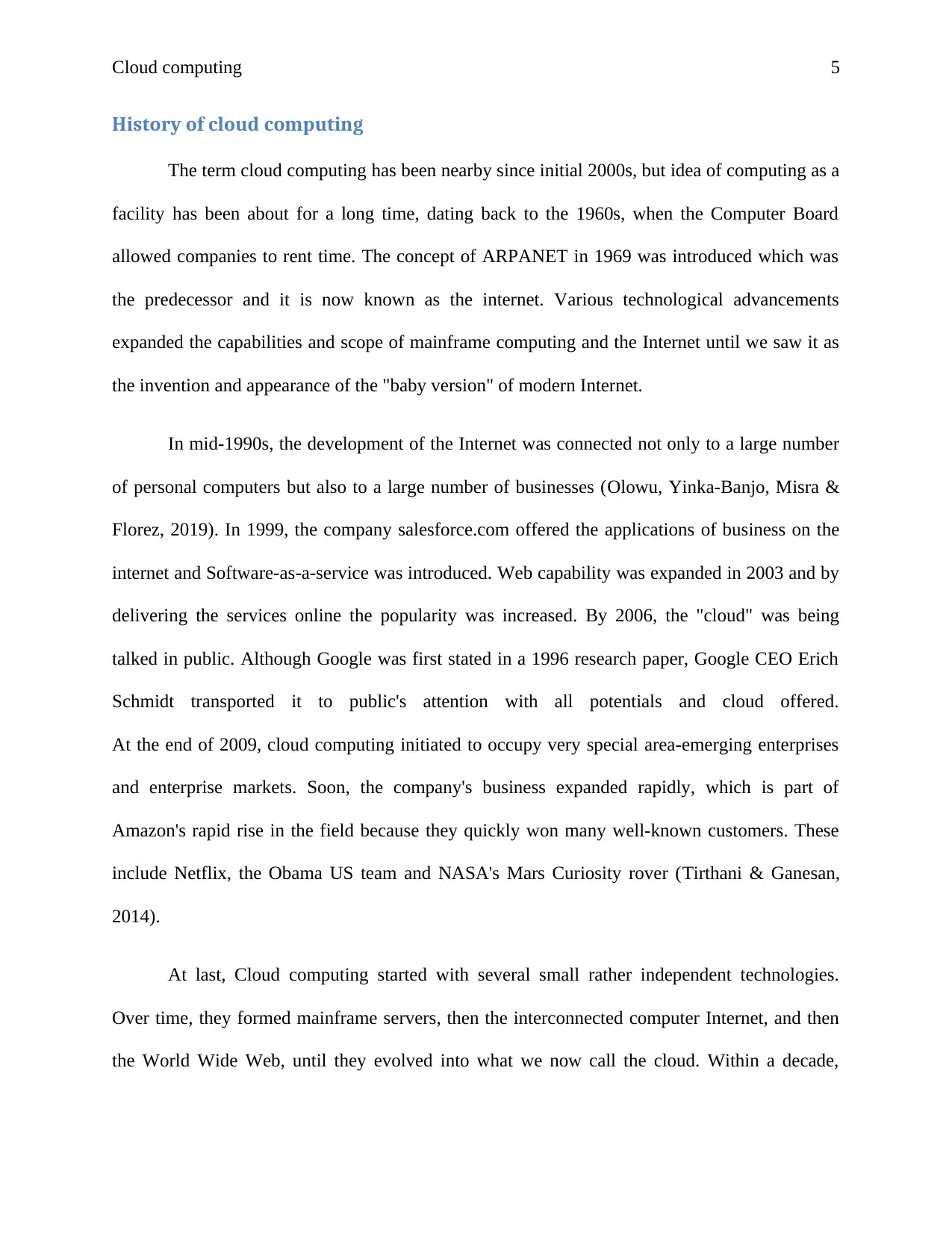
Cloud computing 5
History of cloud computing
The term cloud computing has been nearby since initial 2000s, but idea of computing as a
facility has been about for a long time, dating back to the 1960s, when the Computer Board
allowed companies to rent time. The concept of ARPANET in 1969 was introduced which was
the predecessor and it is now known as the internet. Various technological advancements
expanded the capabilities and scope of mainframe computing and the Internet until we saw it as
the invention and appearance of the "baby version" of modern Internet.
In mid-1990s, the development of the Internet was connected not only to a large number
of personal computers but also to a large number of businesses (Olowu, Yinka-Banjo, Misra &
Florez, 2019). In 1999, the company salesforce.com offered the applications of business on the
internet and Software-as-a-service was introduced. Web capability was expanded in 2003 and by
delivering the services online the popularity was increased. By 2006, the "cloud" was being
talked in public. Although Google was first stated in a 1996 research paper, Google CEO Erich
Schmidt transported it to public's attention with all potentials and cloud offered.
At the end of 2009, cloud computing initiated to occupy very special area-emerging enterprises
and enterprise markets. Soon, the company's business expanded rapidly, which is part of
Amazon's rapid rise in the field because they quickly won many well-known customers. These
include Netflix, the Obama US team and NASA's Mars Curiosity rover (Tirthani & Ganesan,
2014).
At last, Cloud computing started with several small rather independent technologies.
Over time, they formed mainframe servers, then the interconnected computer Internet, and then
the World Wide Web, until they evolved into what we now call the cloud. Within a decade,
History of cloud computing
The term cloud computing has been nearby since initial 2000s, but idea of computing as a
facility has been about for a long time, dating back to the 1960s, when the Computer Board
allowed companies to rent time. The concept of ARPANET in 1969 was introduced which was
the predecessor and it is now known as the internet. Various technological advancements
expanded the capabilities and scope of mainframe computing and the Internet until we saw it as
the invention and appearance of the "baby version" of modern Internet.
In mid-1990s, the development of the Internet was connected not only to a large number
of personal computers but also to a large number of businesses (Olowu, Yinka-Banjo, Misra &
Florez, 2019). In 1999, the company salesforce.com offered the applications of business on the
internet and Software-as-a-service was introduced. Web capability was expanded in 2003 and by
delivering the services online the popularity was increased. By 2006, the "cloud" was being
talked in public. Although Google was first stated in a 1996 research paper, Google CEO Erich
Schmidt transported it to public's attention with all potentials and cloud offered.
At the end of 2009, cloud computing initiated to occupy very special area-emerging enterprises
and enterprise markets. Soon, the company's business expanded rapidly, which is part of
Amazon's rapid rise in the field because they quickly won many well-known customers. These
include Netflix, the Obama US team and NASA's Mars Curiosity rover (Tirthani & Ganesan,
2014).
At last, Cloud computing started with several small rather independent technologies.
Over time, they formed mainframe servers, then the interconnected computer Internet, and then
the World Wide Web, until they evolved into what we now call the cloud. Within a decade,
⊘ This is a preview!⊘
Do you want full access?
Subscribe today to unlock all pages.

Trusted by 1+ million students worldwide
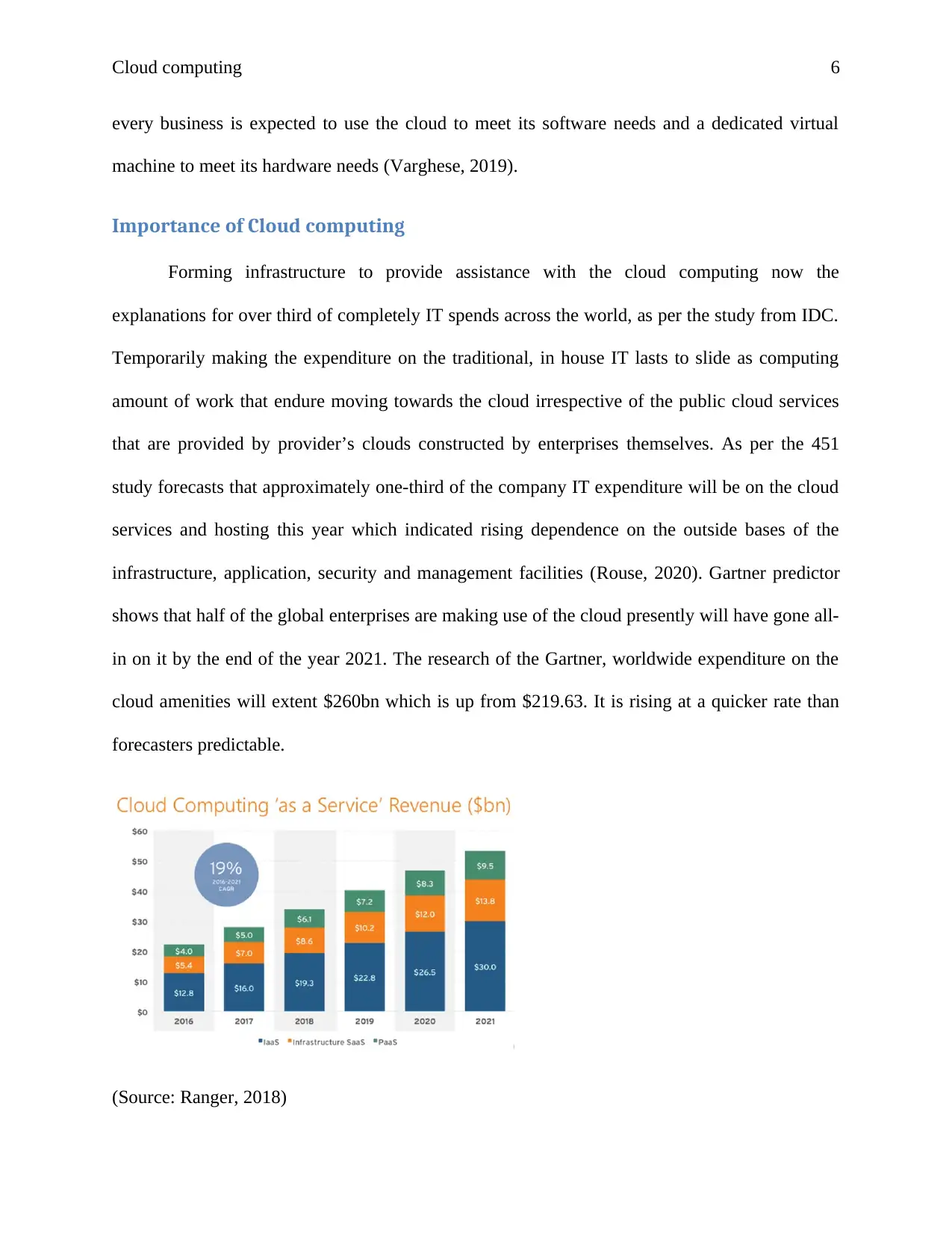
Cloud computing 6
every business is expected to use the cloud to meet its software needs and a dedicated virtual
machine to meet its hardware needs (Varghese, 2019).
Importance of Cloud computing
Forming infrastructure to provide assistance with the cloud computing now the
explanations for over third of completely IT spends across the world, as per the study from IDC.
Temporarily making the expenditure on the traditional, in house IT lasts to slide as computing
amount of work that endure moving towards the cloud irrespective of the public cloud services
that are provided by provider’s clouds constructed by enterprises themselves. As per the 451
study forecasts that approximately one-third of the company IT expenditure will be on the cloud
services and hosting this year which indicated rising dependence on the outside bases of the
infrastructure, application, security and management facilities (Rouse, 2020). Gartner predictor
shows that half of the global enterprises are making use of the cloud presently will have gone all-
in on it by the end of the year 2021. The research of the Gartner, worldwide expenditure on the
cloud amenities will extent $260bn which is up from $219.63. It is rising at a quicker rate than
forecasters predictable.
(Source: Ranger, 2018)
every business is expected to use the cloud to meet its software needs and a dedicated virtual
machine to meet its hardware needs (Varghese, 2019).
Importance of Cloud computing
Forming infrastructure to provide assistance with the cloud computing now the
explanations for over third of completely IT spends across the world, as per the study from IDC.
Temporarily making the expenditure on the traditional, in house IT lasts to slide as computing
amount of work that endure moving towards the cloud irrespective of the public cloud services
that are provided by provider’s clouds constructed by enterprises themselves. As per the 451
study forecasts that approximately one-third of the company IT expenditure will be on the cloud
services and hosting this year which indicated rising dependence on the outside bases of the
infrastructure, application, security and management facilities (Rouse, 2020). Gartner predictor
shows that half of the global enterprises are making use of the cloud presently will have gone all-
in on it by the end of the year 2021. The research of the Gartner, worldwide expenditure on the
cloud amenities will extent $260bn which is up from $219.63. It is rising at a quicker rate than
forecasters predictable.
(Source: Ranger, 2018)
Paraphrase This Document
Need a fresh take? Get an instant paraphrase of this document with our AI Paraphraser
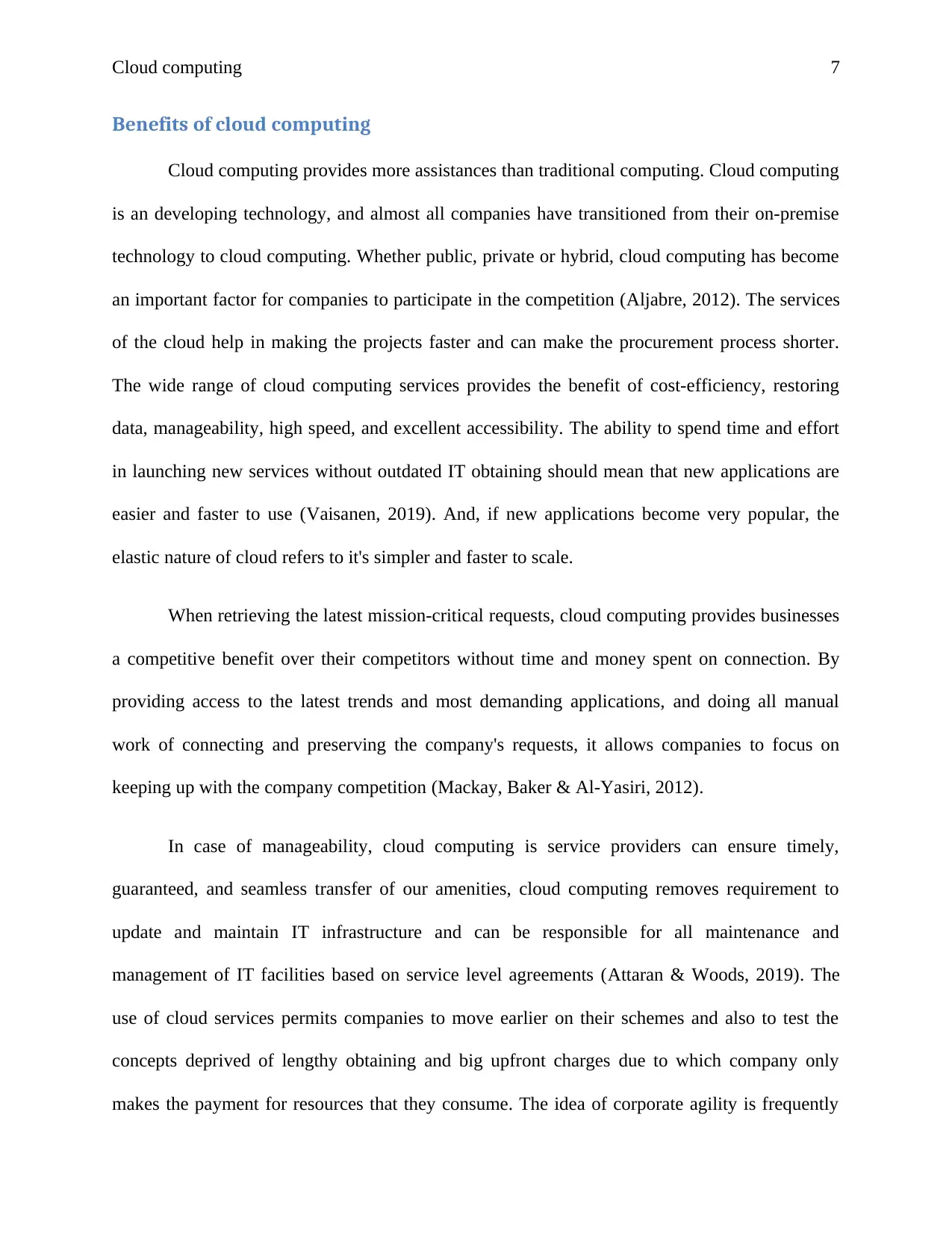
Cloud computing 7
Benefits of cloud computing
Cloud computing provides more assistances than traditional computing. Cloud computing
is an developing technology, and almost all companies have transitioned from their on-premise
technology to cloud computing. Whether public, private or hybrid, cloud computing has become
an important factor for companies to participate in the competition (Aljabre, 2012). The services
of the cloud help in making the projects faster and can make the procurement process shorter.
The wide range of cloud computing services provides the benefit of cost-efficiency, restoring
data, manageability, high speed, and excellent accessibility. The ability to spend time and effort
in launching new services without outdated IT obtaining should mean that new applications are
easier and faster to use (Vaisanen, 2019). And, if new applications become very popular, the
elastic nature of cloud refers to it's simpler and faster to scale.
When retrieving the latest mission-critical requests, cloud computing provides businesses
a competitive benefit over their competitors without time and money spent on connection. By
providing access to the latest trends and most demanding applications, and doing all manual
work of connecting and preserving the company's requests, it allows companies to focus on
keeping up with the company competition (Mackay, Baker & Al-Yasiri, 2012).
In case of manageability, cloud computing is service providers can ensure timely,
guaranteed, and seamless transfer of our amenities, cloud computing removes requirement to
update and maintain IT infrastructure and can be responsible for all maintenance and
management of IT facilities based on service level agreements (Attaran & Woods, 2019). The
use of cloud services permits companies to move earlier on their schemes and also to test the
concepts deprived of lengthy obtaining and big upfront charges due to which company only
makes the payment for resources that they consume. The idea of corporate agility is frequently
Benefits of cloud computing
Cloud computing provides more assistances than traditional computing. Cloud computing
is an developing technology, and almost all companies have transitioned from their on-premise
technology to cloud computing. Whether public, private or hybrid, cloud computing has become
an important factor for companies to participate in the competition (Aljabre, 2012). The services
of the cloud help in making the projects faster and can make the procurement process shorter.
The wide range of cloud computing services provides the benefit of cost-efficiency, restoring
data, manageability, high speed, and excellent accessibility. The ability to spend time and effort
in launching new services without outdated IT obtaining should mean that new applications are
easier and faster to use (Vaisanen, 2019). And, if new applications become very popular, the
elastic nature of cloud refers to it's simpler and faster to scale.
When retrieving the latest mission-critical requests, cloud computing provides businesses
a competitive benefit over their competitors without time and money spent on connection. By
providing access to the latest trends and most demanding applications, and doing all manual
work of connecting and preserving the company's requests, it allows companies to focus on
keeping up with the company competition (Mackay, Baker & Al-Yasiri, 2012).
In case of manageability, cloud computing is service providers can ensure timely,
guaranteed, and seamless transfer of our amenities, cloud computing removes requirement to
update and maintain IT infrastructure and can be responsible for all maintenance and
management of IT facilities based on service level agreements (Attaran & Woods, 2019). The
use of cloud services permits companies to move earlier on their schemes and also to test the
concepts deprived of lengthy obtaining and big upfront charges due to which company only
makes the payment for resources that they consume. The idea of corporate agility is frequently
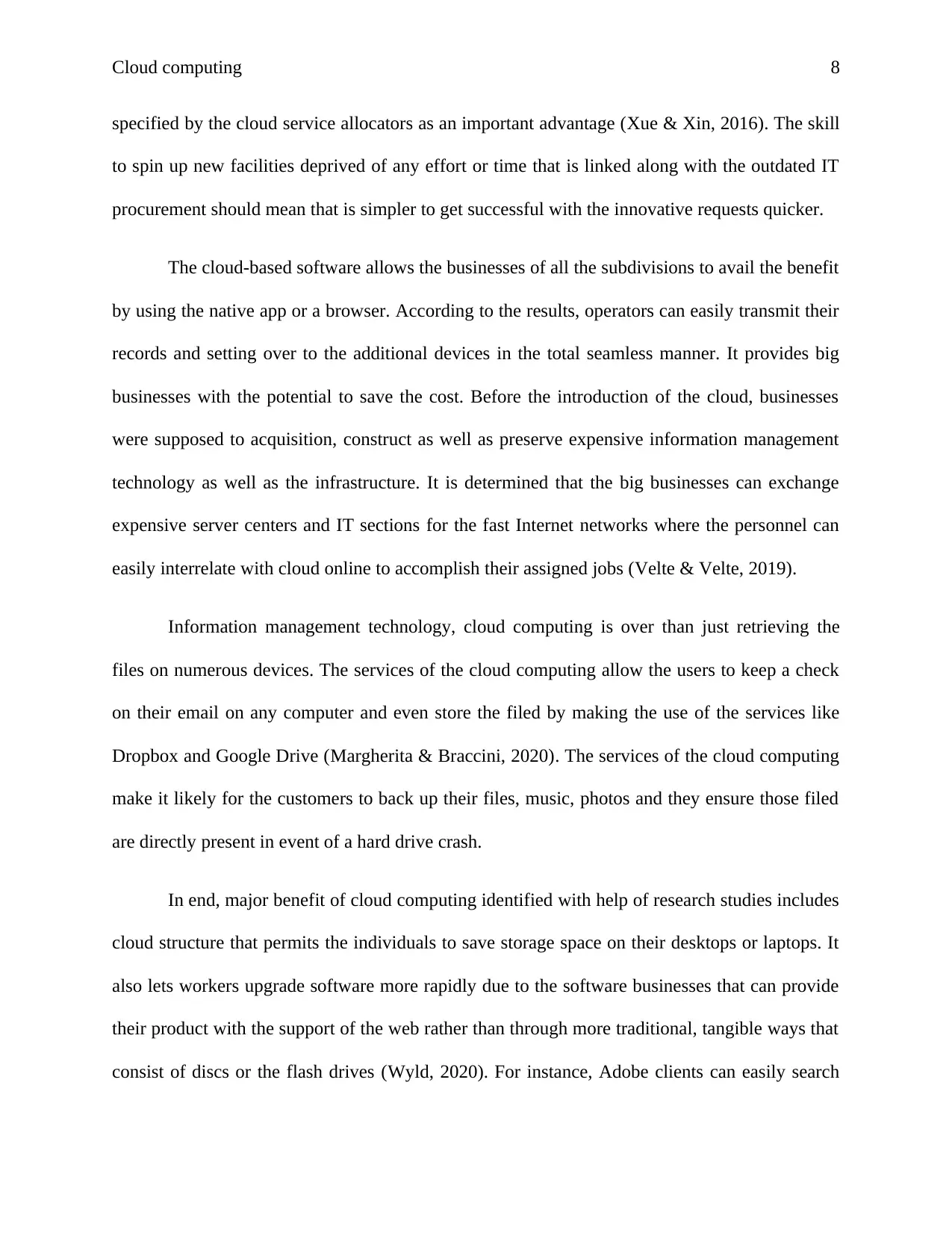
Cloud computing 8
specified by the cloud service allocators as an important advantage (Xue & Xin, 2016). The skill
to spin up new facilities deprived of any effort or time that is linked along with the outdated IT
procurement should mean that is simpler to get successful with the innovative requests quicker.
The cloud-based software allows the businesses of all the subdivisions to avail the benefit
by using the native app or a browser. According to the results, operators can easily transmit their
records and setting over to the additional devices in the total seamless manner. It provides big
businesses with the potential to save the cost. Before the introduction of the cloud, businesses
were supposed to acquisition, construct as well as preserve expensive information management
technology as well as the infrastructure. It is determined that the big businesses can exchange
expensive server centers and IT sections for the fast Internet networks where the personnel can
easily interrelate with cloud online to accomplish their assigned jobs (Velte & Velte, 2019).
Information management technology, cloud computing is over than just retrieving the
files on numerous devices. The services of the cloud computing allow the users to keep a check
on their email on any computer and even store the filed by making the use of the services like
Dropbox and Google Drive (Margherita & Braccini, 2020). The services of the cloud computing
make it likely for the customers to back up their files, music, photos and they ensure those filed
are directly present in event of a hard drive crash.
In end, major benefit of cloud computing identified with help of research studies includes
cloud structure that permits the individuals to save storage space on their desktops or laptops. It
also lets workers upgrade software more rapidly due to the software businesses that can provide
their product with the support of the web rather than through more traditional, tangible ways that
consist of discs or the flash drives (Wyld, 2020). For instance, Adobe clients can easily search
specified by the cloud service allocators as an important advantage (Xue & Xin, 2016). The skill
to spin up new facilities deprived of any effort or time that is linked along with the outdated IT
procurement should mean that is simpler to get successful with the innovative requests quicker.
The cloud-based software allows the businesses of all the subdivisions to avail the benefit
by using the native app or a browser. According to the results, operators can easily transmit their
records and setting over to the additional devices in the total seamless manner. It provides big
businesses with the potential to save the cost. Before the introduction of the cloud, businesses
were supposed to acquisition, construct as well as preserve expensive information management
technology as well as the infrastructure. It is determined that the big businesses can exchange
expensive server centers and IT sections for the fast Internet networks where the personnel can
easily interrelate with cloud online to accomplish their assigned jobs (Velte & Velte, 2019).
Information management technology, cloud computing is over than just retrieving the
files on numerous devices. The services of the cloud computing allow the users to keep a check
on their email on any computer and even store the filed by making the use of the services like
Dropbox and Google Drive (Margherita & Braccini, 2020). The services of the cloud computing
make it likely for the customers to back up their files, music, photos and they ensure those filed
are directly present in event of a hard drive crash.
In end, major benefit of cloud computing identified with help of research studies includes
cloud structure that permits the individuals to save storage space on their desktops or laptops. It
also lets workers upgrade software more rapidly due to the software businesses that can provide
their product with the support of the web rather than through more traditional, tangible ways that
consist of discs or the flash drives (Wyld, 2020). For instance, Adobe clients can easily search
⊘ This is a preview!⊘
Do you want full access?
Subscribe today to unlock all pages.

Trusted by 1+ million students worldwide
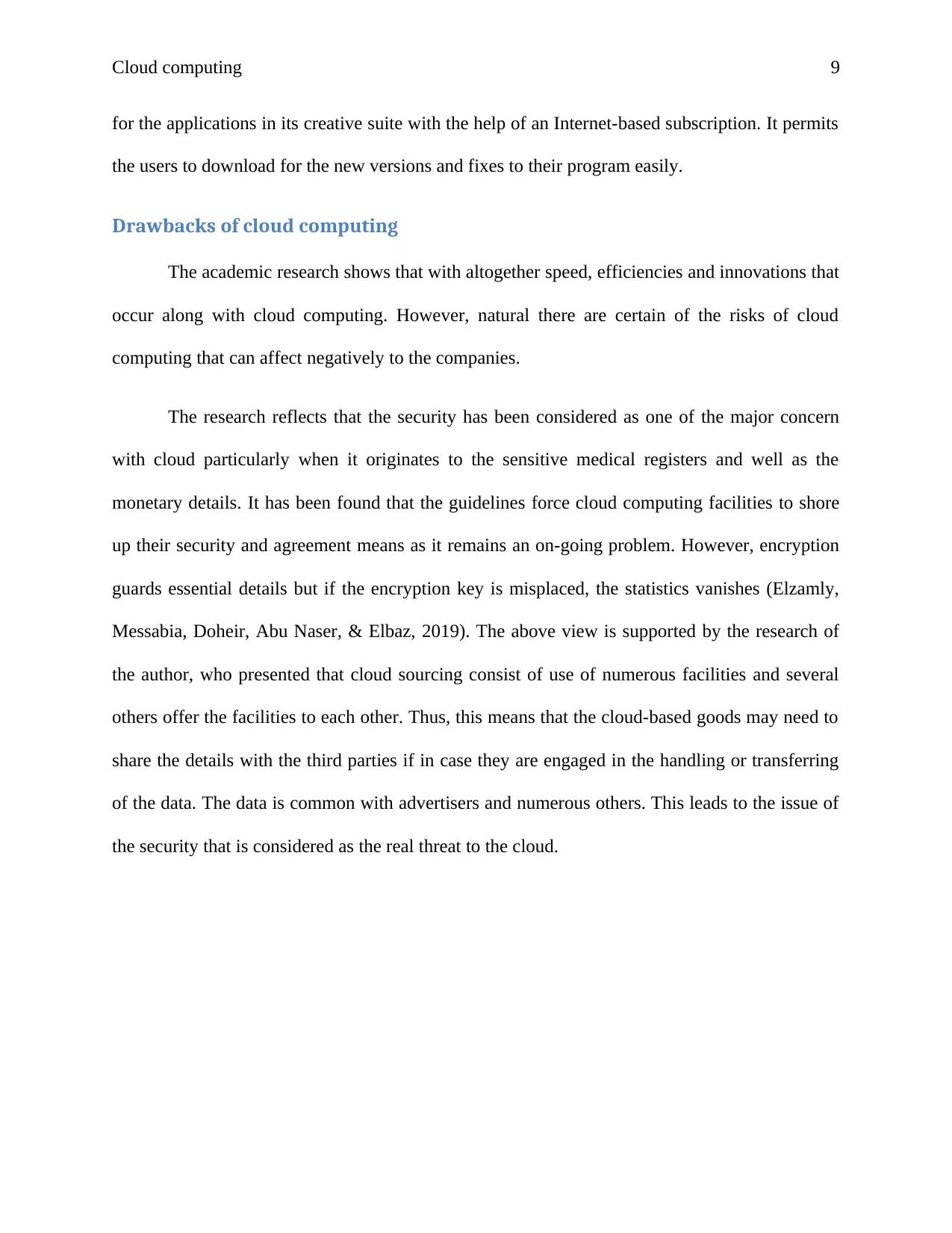
Cloud computing 9
for the applications in its creative suite with the help of an Internet-based subscription. It permits
the users to download for the new versions and fixes to their program easily.
Drawbacks of cloud computing
The academic research shows that with altogether speed, efficiencies and innovations that
occur along with cloud computing. However, natural there are certain of the risks of cloud
computing that can affect negatively to the companies.
The research reflects that the security has been considered as one of the major concern
with cloud particularly when it originates to the sensitive medical registers and well as the
monetary details. It has been found that the guidelines force cloud computing facilities to shore
up their security and agreement means as it remains an on-going problem. However, encryption
guards essential details but if the encryption key is misplaced, the statistics vanishes (Elzamly,
Messabia, Doheir, Abu Naser, & Elbaz, 2019). The above view is supported by the research of
the author, who presented that cloud sourcing consist of use of numerous facilities and several
others offer the facilities to each other. Thus, this means that the cloud-based goods may need to
share the details with the third parties if in case they are engaged in the handling or transferring
of the data. The data is common with advertisers and numerous others. This leads to the issue of
the security that is considered as the real threat to the cloud.
for the applications in its creative suite with the help of an Internet-based subscription. It permits
the users to download for the new versions and fixes to their program easily.
Drawbacks of cloud computing
The academic research shows that with altogether speed, efficiencies and innovations that
occur along with cloud computing. However, natural there are certain of the risks of cloud
computing that can affect negatively to the companies.
The research reflects that the security has been considered as one of the major concern
with cloud particularly when it originates to the sensitive medical registers and well as the
monetary details. It has been found that the guidelines force cloud computing facilities to shore
up their security and agreement means as it remains an on-going problem. However, encryption
guards essential details but if the encryption key is misplaced, the statistics vanishes (Elzamly,
Messabia, Doheir, Abu Naser, & Elbaz, 2019). The above view is supported by the research of
the author, who presented that cloud sourcing consist of use of numerous facilities and several
others offer the facilities to each other. Thus, this means that the cloud-based goods may need to
share the details with the third parties if in case they are engaged in the handling or transferring
of the data. The data is common with advertisers and numerous others. This leads to the issue of
the security that is considered as the real threat to the cloud.
Paraphrase This Document
Need a fresh take? Get an instant paraphrase of this document with our AI Paraphraser
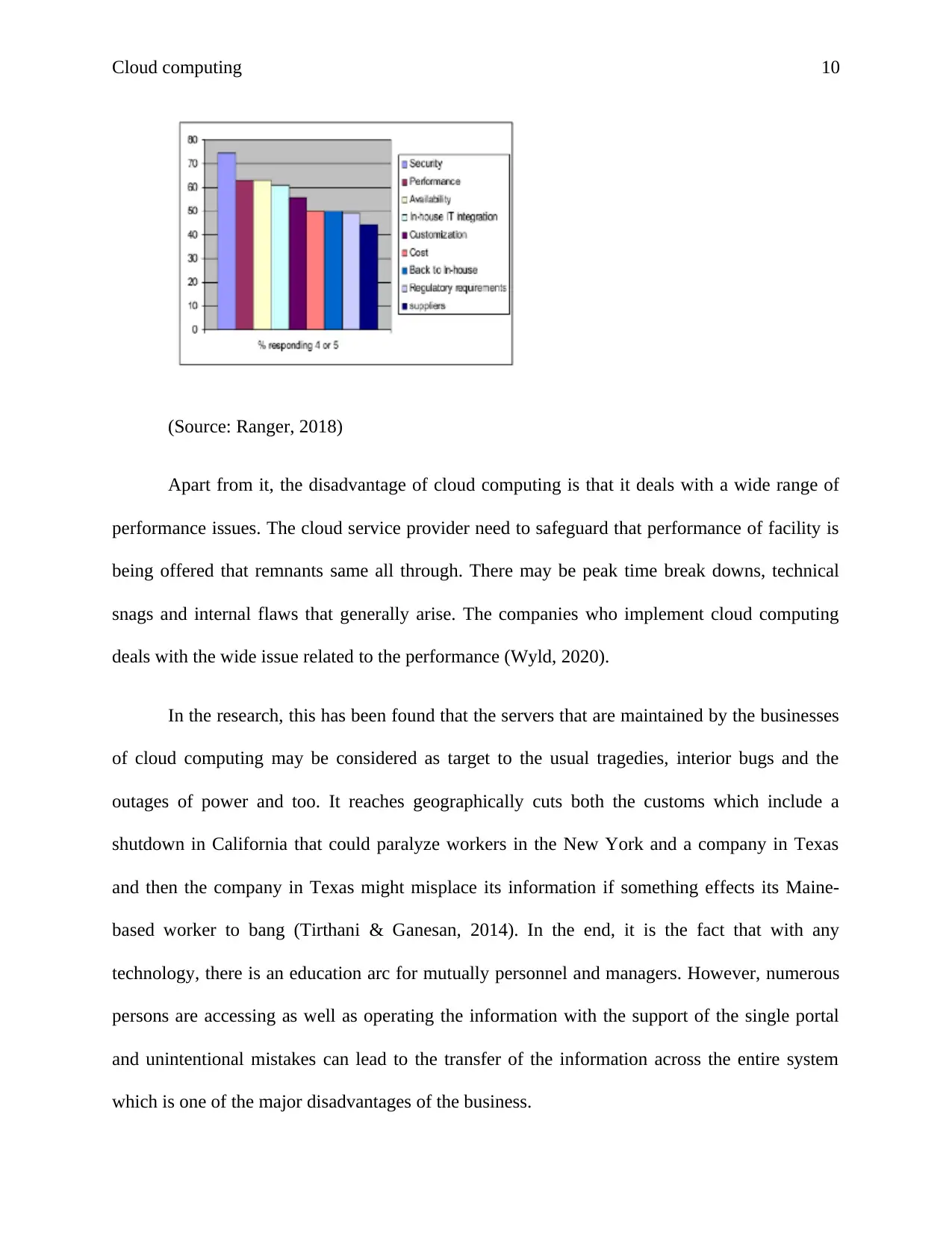
Cloud computing 10
(Source: Ranger, 2018)
Apart from it, the disadvantage of cloud computing is that it deals with a wide range of
performance issues. The cloud service provider need to safeguard that performance of facility is
being offered that remnants same all through. There may be peak time break downs, technical
snags and internal flaws that generally arise. The companies who implement cloud computing
deals with the wide issue related to the performance (Wyld, 2020).
In the research, this has been found that the servers that are maintained by the businesses
of cloud computing may be considered as target to the usual tragedies, interior bugs and the
outages of power and too. It reaches geographically cuts both the customs which include a
shutdown in California that could paralyze workers in the New York and a company in Texas
and then the company in Texas might misplace its information if something effects its Maine-
based worker to bang (Tirthani & Ganesan, 2014). In the end, it is the fact that with any
technology, there is an education arc for mutually personnel and managers. However, numerous
persons are accessing as well as operating the information with the support of the single portal
and unintentional mistakes can lead to the transfer of the information across the entire system
which is one of the major disadvantages of the business.
(Source: Ranger, 2018)
Apart from it, the disadvantage of cloud computing is that it deals with a wide range of
performance issues. The cloud service provider need to safeguard that performance of facility is
being offered that remnants same all through. There may be peak time break downs, technical
snags and internal flaws that generally arise. The companies who implement cloud computing
deals with the wide issue related to the performance (Wyld, 2020).
In the research, this has been found that the servers that are maintained by the businesses
of cloud computing may be considered as target to the usual tragedies, interior bugs and the
outages of power and too. It reaches geographically cuts both the customs which include a
shutdown in California that could paralyze workers in the New York and a company in Texas
and then the company in Texas might misplace its information if something effects its Maine-
based worker to bang (Tirthani & Ganesan, 2014). In the end, it is the fact that with any
technology, there is an education arc for mutually personnel and managers. However, numerous
persons are accessing as well as operating the information with the support of the single portal
and unintentional mistakes can lead to the transfer of the information across the entire system
which is one of the major disadvantages of the business.
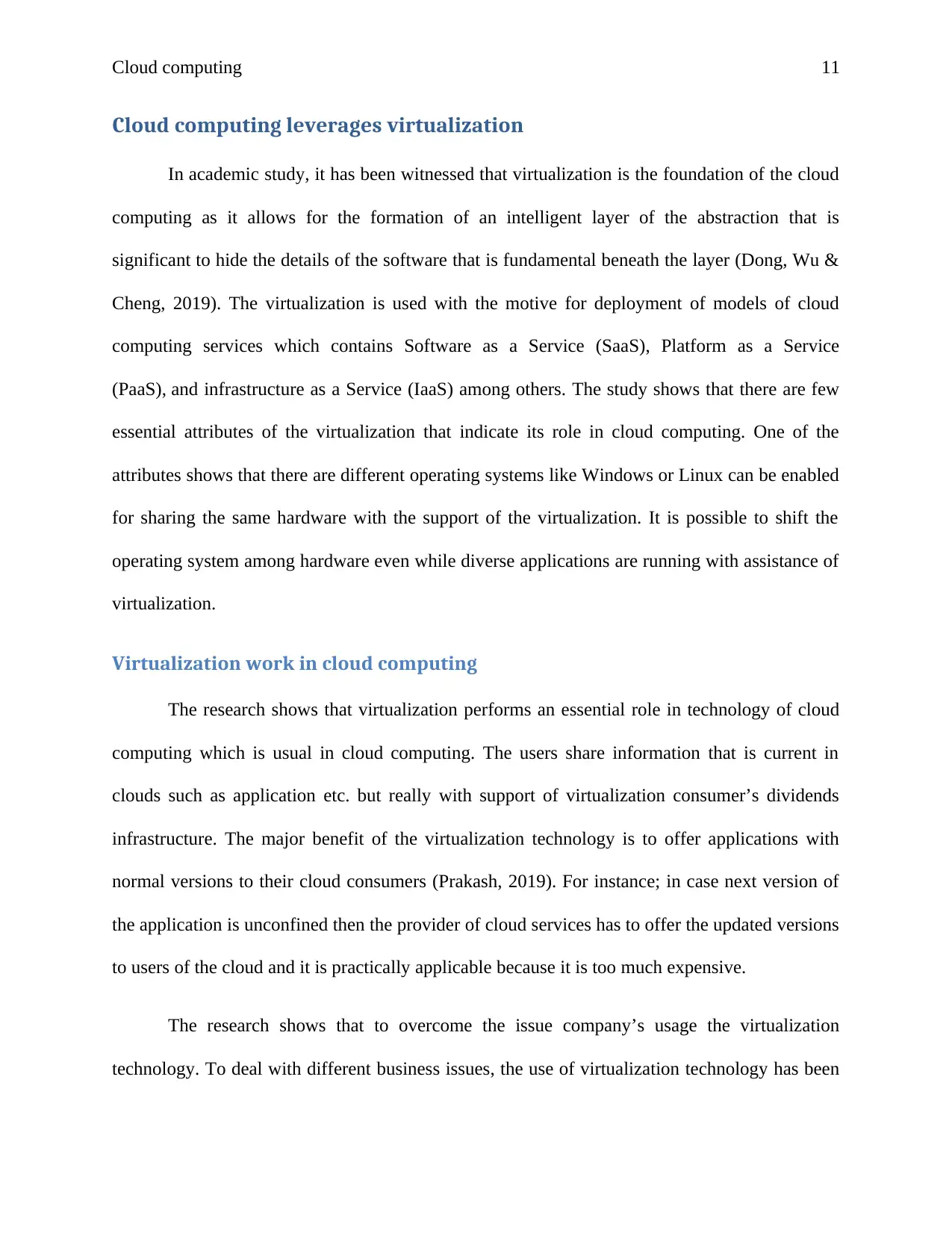
Cloud computing 11
Cloud computing leverages virtualization
In academic study, it has been witnessed that virtualization is the foundation of the cloud
computing as it allows for the formation of an intelligent layer of the abstraction that is
significant to hide the details of the software that is fundamental beneath the layer (Dong, Wu &
Cheng, 2019). The virtualization is used with the motive for deployment of models of cloud
computing services which contains Software as a Service (SaaS), Platform as a Service
(PaaS), and infrastructure as a Service (IaaS) among others. The study shows that there are few
essential attributes of the virtualization that indicate its role in cloud computing. One of the
attributes shows that there are different operating systems like Windows or Linux can be enabled
for sharing the same hardware with the support of the virtualization. It is possible to shift the
operating system among hardware even while diverse applications are running with assistance of
virtualization.
Virtualization work in cloud computing
The research shows that virtualization performs an essential role in technology of cloud
computing which is usual in cloud computing. The users share information that is current in
clouds such as application etc. but really with support of virtualization consumer’s dividends
infrastructure. The major benefit of the virtualization technology is to offer applications with
normal versions to their cloud consumers (Prakash, 2019). For instance; in case next version of
the application is unconfined then the provider of cloud services has to offer the updated versions
to users of the cloud and it is practically applicable because it is too much expensive.
The research shows that to overcome the issue company’s usage the virtualization
technology. To deal with different business issues, the use of virtualization technology has been
Cloud computing leverages virtualization
In academic study, it has been witnessed that virtualization is the foundation of the cloud
computing as it allows for the formation of an intelligent layer of the abstraction that is
significant to hide the details of the software that is fundamental beneath the layer (Dong, Wu &
Cheng, 2019). The virtualization is used with the motive for deployment of models of cloud
computing services which contains Software as a Service (SaaS), Platform as a Service
(PaaS), and infrastructure as a Service (IaaS) among others. The study shows that there are few
essential attributes of the virtualization that indicate its role in cloud computing. One of the
attributes shows that there are different operating systems like Windows or Linux can be enabled
for sharing the same hardware with the support of the virtualization. It is possible to shift the
operating system among hardware even while diverse applications are running with assistance of
virtualization.
Virtualization work in cloud computing
The research shows that virtualization performs an essential role in technology of cloud
computing which is usual in cloud computing. The users share information that is current in
clouds such as application etc. but really with support of virtualization consumer’s dividends
infrastructure. The major benefit of the virtualization technology is to offer applications with
normal versions to their cloud consumers (Prakash, 2019). For instance; in case next version of
the application is unconfined then the provider of cloud services has to offer the updated versions
to users of the cloud and it is practically applicable because it is too much expensive.
The research shows that to overcome the issue company’s usage the virtualization
technology. To deal with different business issues, the use of virtualization technology has been
⊘ This is a preview!⊘
Do you want full access?
Subscribe today to unlock all pages.

Trusted by 1+ million students worldwide
1 out of 21
Related Documents
Your All-in-One AI-Powered Toolkit for Academic Success.
+13062052269
info@desklib.com
Available 24*7 on WhatsApp / Email
![[object Object]](/_next/static/media/star-bottom.7253800d.svg)
Unlock your academic potential
Copyright © 2020–2025 A2Z Services. All Rights Reserved. Developed and managed by ZUCOL.




